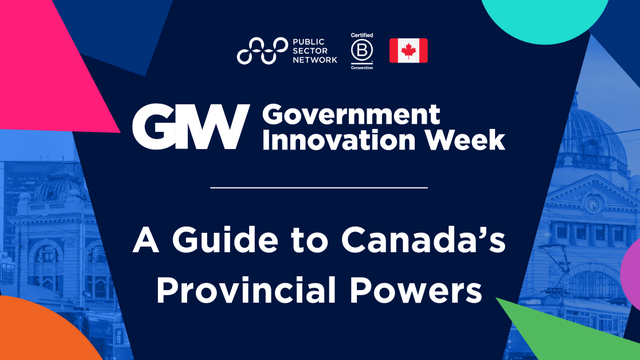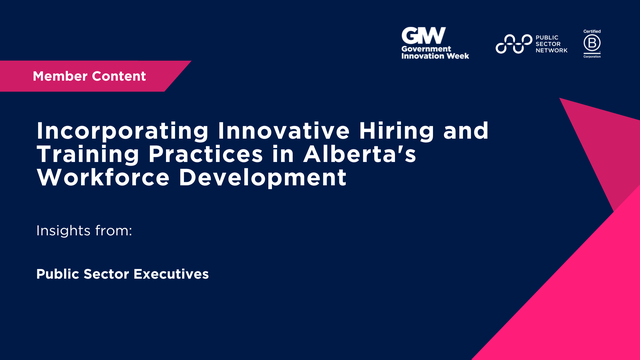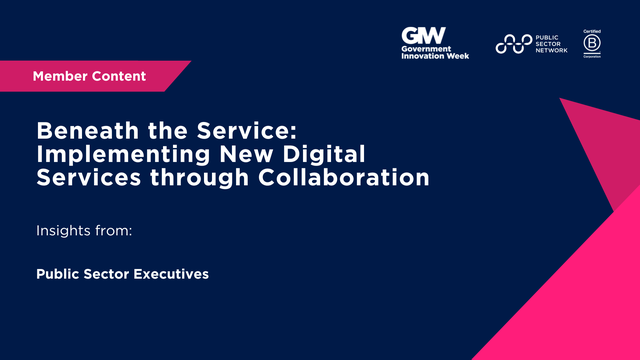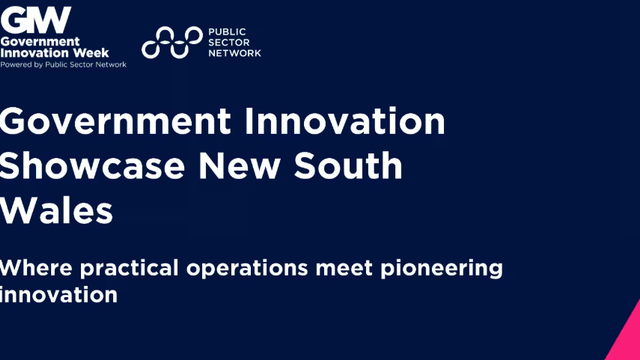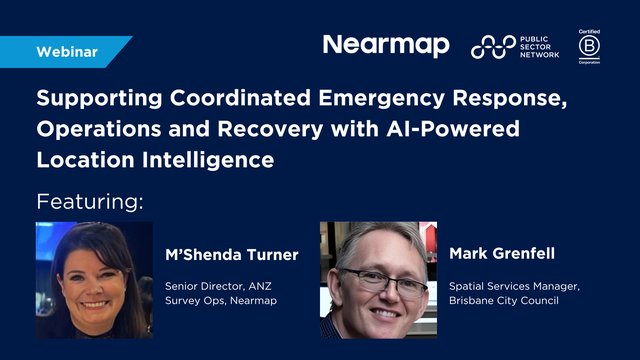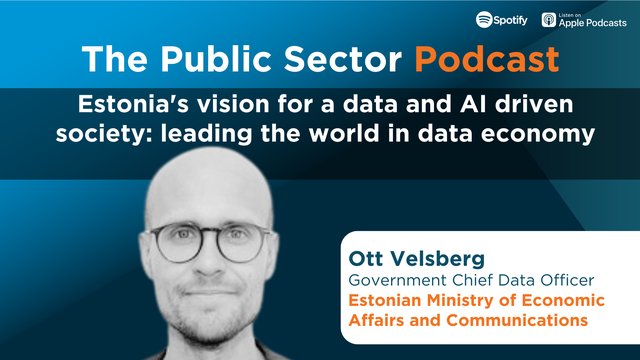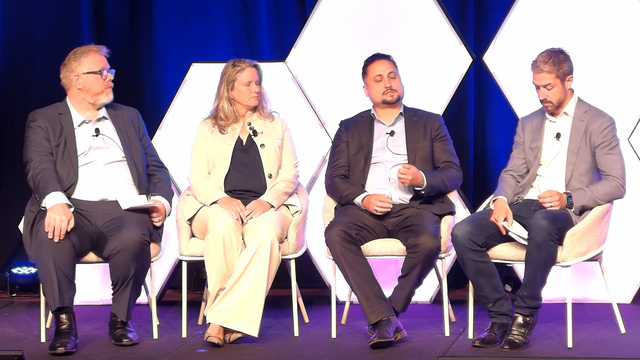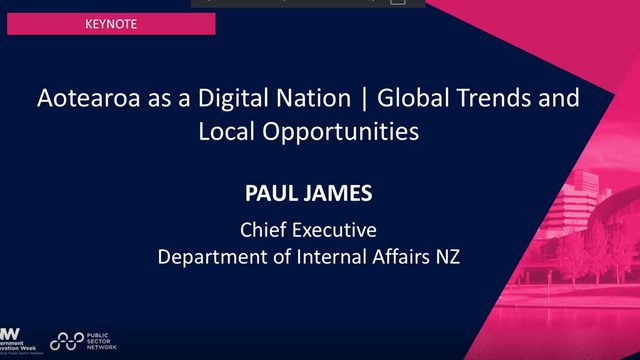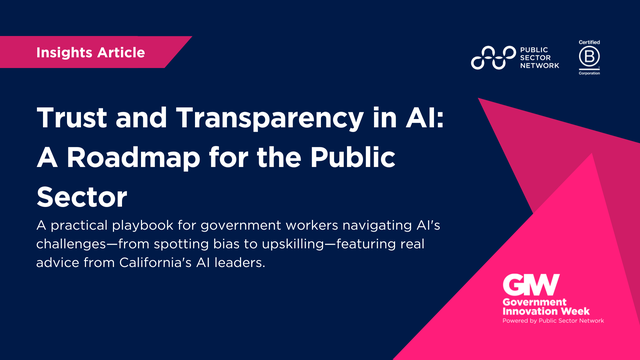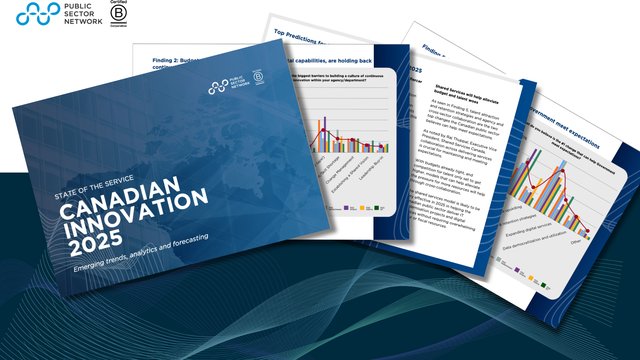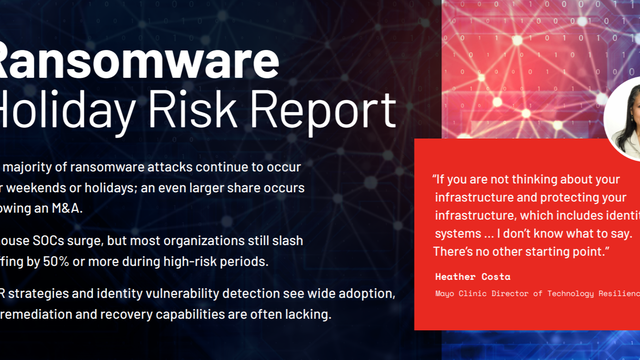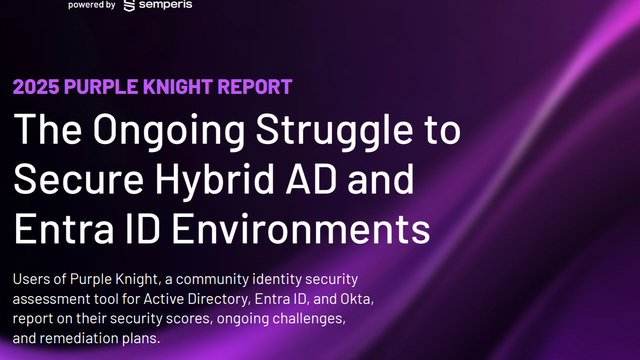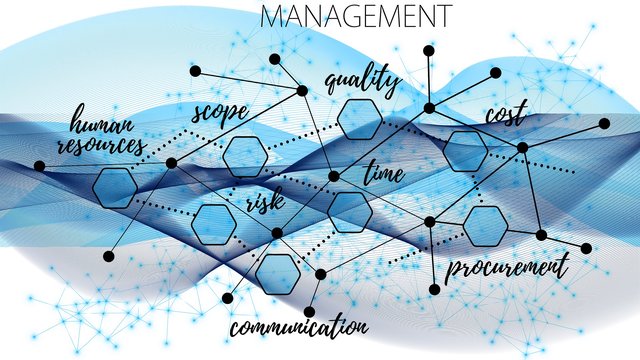

The Alberta Government Innovation Showcase 2024 provided a crucial platform for exploring the key challenges and opportunities shaping the province’s digital government landscape. Discussions centered on workforce development, cybersecurity, budget constraints, and the role of digital services in modern governance. To capture real-time perspectives, attendees participated in polling, offering valuable insights into Alberta’s unique public sector priorities and how they compare to national trends.
The results reveal a strong emphasis on upskilling, business continuity, and cybersecurity, underscoring Alberta’s focus on resilience and long-term workforce development. At the same time, divergences in collaboration efforts, employer branding, and talent attraction highlight areas where Alberta’s strategy differs from national approaches. By examining these findings, this report provides a comprehensive overview of Alberta’s evolving public sector priorities and the key factors influencing its digital transformation efforts in 2024.

Top Priority: Modernizing Data & Cybersecurity Processes
Alberta respondents overwhelmingly prioritized modernizing data and cybersecurity processes (35%), significantly higher than the national average of 14%. This suggests a heightened regional focus on strengthening cyber resilience, likely driven by increased security threats, evolving regulatory requirements, or recent high-profile breaches. While cybersecurity remains a key concern nationally, Alberta's prioritization signals an acute need for enhanced safeguards in the province’s digital infrastructure.
Biggest Disparity: Business Continuity Planning vs. Process Automation
One of the most striking contrasts is Alberta’s strong focus on building resiliency and improving business continuity plans (19%) compared to the national average of just 5%. This substantial difference suggests that organizations in Alberta are placing greater emphasis on ensuring operational stability, potentially in response to economic volatility or regional-specific challenges.
Conversely, transforming and automating processes—a leading national priority (26%)—was deprioritized in Alberta (9%). This indicates that while digital automation remains important, Alberta organizations may currently be focusing more on foundational stability rather than widespread process transformation.
Notable Differences in Priorities
- Becoming More Data-Driven (0% in Alberta vs. 11% Nationally): Unlike other regions, no respondents in Alberta selected data-driven decision-making as a top priority. This is a stark contrast and could reflect a gap in data maturity, a heavier reliance on traditional decision-making structures, or a current focus on other pressing digital needs.
- Collaboration with Other Government Tiers (5% in Alberta vs. 11% Nationally): Alberta respondents also placed less emphasis on intergovernmental collaboration, which could indicate that regional organizations are prioritizing internal modernization efforts over broader cooperative initiatives at this stage.
Financial Pressures Take Center Stage: Alberta’s Innovation Barriers
Budget Constraints Dominate as the Primary Challenge
Alberta respondents overwhelmingly identified budget constraints (51%) as the most significant barrier to innovation, a 20-point increase over the national average (31%). This stark contrast underscores the acute financial pressures faced by organizations in the province, likely stemming from regional economic conditions, funding limitations, or a constrained fiscal environment. The heightened focus on financial barriers suggests that securing investment for digital transformation initiatives remains a fundamental challenge, necessitating creative budget allocation strategies or alternative funding mechanisms.
A Notable Lack of Focus on Digital Capabilities
Unlike the national trend (8% prioritizing digital capabilities), Alberta respondents did not cite digital readiness (0%) as a significant barrier. This could imply a perception that Alberta organizations already have the necessary foundational digital infrastructure or that other challenges—particularly financial constraints—are overshadowing concerns about digital maturity. However, overlooking digital capability gaps may pose long-term risks, particularly as technology continues to evolve and become more complex.
Policy and Process Challenges Less Emphasized in Alberta
Red tape and bureaucratic hurdles were ranked significantly lower in Alberta (10%) compared to the national average (24%). This suggests that while policy-related inefficiencies remain a challenge, they are not as pressing as financial constraints in the province. This could indicate that Alberta organizations either experience fewer regulatory barriers or have developed effective strategies for navigating existing policies.
Workforce and Leadership Considerations
- Talent and Skill Shortages (15%) were slightly more emphasized in Alberta than nationally (12%), indicating ongoing workforce capacity concerns. This aligns with broader trends in the digital economy, where securing specialized talent remains a challenge.
- Change Management (12%) remained consistent with national results, signaling that organizations in Alberta face similar cultural and operational hurdles in adopting new processes or technologies.
- Leadership Buy-in (7%) was slightly higher than the national average (6%), suggesting that executive support is recognized as a necessary enabler for digital initiatives, though still not a primary barrier.
Navigating Alberta’s Public Sector Challenges: A Shift Toward Security and Stability
Economic Constraints Remain the Leading Concern
Economic challenges—budgets and competing priorities (30%)—remain the top concern for Alberta respondents, though slightly lower than the national average (35%). While financial pressures are still the most significant obstacle for public sector organizations, Alberta’s emphasis suggests a slightly more balanced distribution of concerns compared to other regions. This may indicate that while fiscal constraints are recognized, organizations in Alberta are also prioritizing other structural and technological challenges.
Cybersecurity is a Notably Higher Priority in Alberta
One of the most striking differences in Alberta’s responses is the elevated focus on cybersecurity and information security (14%), significantly exceeding the national average (4%). This suggests that public sector leaders in Alberta are particularly attuned to emerging cybersecurity threats, regulatory compliance, and the growing need to protect digital infrastructure. This heightened concern could be influenced by regional experiences with cyber incidents, increasing ransomware threats, or a push for stronger public-sector data protection frameworks.
Workforce Challenges Persist, But Are Less Pressing than Nationally
At 25%, workforce-related challenges such as talent attraction and retention remain a major issue in Alberta but fall below the national average (30%). This may indicate a relative confidence in workforce retention strategies or less immediate hiring pressure compared to other provinces. However, given the rapid evolution of technology and the increasing demand for specialized skills, ensuring a strong pipeline of digital talent will remain crucial for Alberta’s long-term resilience.
The Technological Divide is in Line with National Concerns
Alberta respondents closely align with the national average when it comes to concerns around the digital divide and the rate of technological change (18% vs. 17%). This demonstrates a shared recognition of the need to bridge accessibility gaps and keep pace with rapid technological advancements. As digital transformation accelerates, ensuring equitable access to technology, particularly in rural and underserved communities, will be vital for sustainable public sector modernization.
Minimal Concern for Environmental and Demographic Challenges
- Demographic concerns, including population expectations and citizen trust (9%), match the national average, suggesting a balanced approach to public engagement and service delivery expectations.
- Environmental challenges, particularly the metro/rural divide (0%), were deprioritized in Alberta, aligning with the already minimal national concern (1%). This may indicate that organizations view other infrastructure and economic challenges as more pressing for digital transformation efforts.
- Social challenges, such as accessibility and equal access for all (5%), in line with the national average (4%), reflecting some focus on digital inclusivity, though not a primary concern for most respondents.
Talent Strategies in Alberta: A Strong Push for Flexibility Amid Workforce Uncertainty
Upskilling Remains the Leading Workforce Priority
Similar to national trends, Alberta respondents overwhelmingly prioritized focusing on career paths and upskilling (29%) as the primary strategy for addressing talent challenges. This aligns with the ongoing shift toward building internal capacity to meet evolving workforce needs, particularly in areas requiring specialized digital skills. As the public sector continues to modernize, investing in workforce development ensures long-term sustainability and adaptability to emerging challenges.
Greater Emphasis on Expanding Talent Pools Through Flexible Work
One of the most notable differences in Alberta’s responses is the higher prioritization of expanding talent pools through flexible work arrangements (24%), compared to the national average of 17%. This suggests that Alberta organizations recognize the value of remote and hybrid work in attracting diverse talent, particularly in a geographically vast province with workforce distribution challenges. By leveraging flexible work structures, Alberta agencies can tap into a broader talent pool, reduce geographic limitations, and improve retention.
Limited Focus on Employer Branding and Value Alignment
- Improving the government brand (2%) was deprioritized compared to the national average (8%), indicating that Alberta respondents may see other factors—such as career growth or flexibility—as more critical to attracting and retaining talent. However, undervaluing employer branding could pose a long-term challenge as competition for skilled workers intensifies.
- Aligning with employee values (2%) was also notably lower than the national average (11%), suggesting that Alberta organizations may currently place less emphasis on workplace culture and purpose-driven employment as key drivers for recruitment.
A Higher Proportion Acknowledging Workforce Strategy Gaps
A significant 32% of Alberta respondents indicated “We’re not, but we should be,” slightly above the national average of 29%. This acknowledgment of workforce strategy gaps suggests a growing awareness of the need to rethink talent acquisition and retention approaches. This response may reflect a recognition that while efforts are being made, additional focus is needed to fully address the evolving workforce landscape.
Higher Rate of Organizations Not Prioritizing Workforce Initiatives
Interestingly, 10% of Alberta respondents stated workforce strategy is “not a current priority,” compared to just 4% nationally. This signals a notable divergence from national efforts, where most regions are actively working to enhance workforce-related initiatives. If left unaddressed, this could indicate a potential misalignment between organizational readiness and long-term workforce sustainability.
Strengthening Alberta’s Public Sector: Workforce Development and Collaboration as Key Drivers
Workforce Upskilling Takes Center Stage
One of the most striking differences in Alberta’s responses is the stronger emphasis on workforce upskilling (21%) compared to the national average (9%). This suggests that Alberta public sector organizations recognize the need to develop internal talent to meet evolving service demands. With rapid advancements in digital services and the increasing complexity of public sector work, building workforce capacity through upskilling is seen as a critical investment in Alberta’s future governance capabilities.
Talent Attraction and Retention Still a Major Concern
While talent attraction and retention strategies (28%) remain the top priority in Alberta, they are less emphasized than the national average (36%). This could indicate a slightly lower perceived urgency around hiring and retention challenges or a stronger belief that workforce upskilling will help mitigate talent shortages over time. Given the increasing competition for specialized talent in both public and private sectors, balancing immediate hiring needs with long-term workforce development will be crucial for Alberta’s public service sustainability.
Collaboration Slightly Less Emphasized
Alberta respondents placed cross-agency and cross-sector collaboration (23%) slightly below the national average (27%). While collaboration remains an important focus, this moderate gap suggests that Alberta may still have opportunities to strengthen intergovernmental and cross-industry partnerships. As digital transformation accelerates, fostering greater collaboration could unlock more innovative solutions and streamlined service delivery models.
Digital Services and Data Democratization Align with National Trends
- Expanding digital services (15%) closely mirrors the national average (16%), demonstrating a consistent focus on modernizing service delivery and ensuring greater accessibility to government services.
- Improved data democratization and utilization (11%) is slightly above the national average (9%), reflecting a growing awareness of the need to leverage data for informed decision-making. With increased emphasis on cybersecurity in Alberta’s public sector, ensuring secure yet accessible data frameworks will be essential for maximizing the value of digital initiatives.
Conclusion: Alberta’s Path to a Resilient and Future-Ready Public Sector
Across the polls, Alberta’s public sector priorities reveal a strong emphasis on workforce upskilling, cybersecurity, and flexible talent strategies—highlighting a pragmatic approach to digital transformation and organizational resilience. However, the findings also indicate challenges in budget constraints, collaboration, and long-term workforce planning that could hinder the province’s ability to fully meet evolving public expectations.
The elevated focus on cybersecurity and business continuity planning signals a regional recognition of emerging digital threats and the need for robust infrastructure. At the same time, Alberta’s strong prioritization of upskilling over immediate talent attraction efforts suggests a long-term investment in workforce sustainability rather than short-term hiring fixes. While this approach fosters internal growth, ensuring an attractive and competitive employment environment will be essential to retaining top talent in the public sector.
Despite Alberta’s growing digital maturity, collaboration and intergovernmental partnerships remain slightly less emphasized than nationally, pointing to potential missed opportunities for leveraging shared resources and knowledge exchange. Additionally, lower prioritization of employer branding and workplace values may hinder the province’s ability to compete for skilled professionals against private sector opportunities.
To drive sustainable innovation and service excellence, Alberta’s public sector must strike a balance between financial constraints, talent retention strategies, and inter-agency collaboration. By continuing to invest in workforce development, strengthening cybersecurity measures, and expanding digital service capabilities, Alberta has the potential to build a resilient, adaptable, and future-ready public sector that effectively meets the needs of its citizens.


